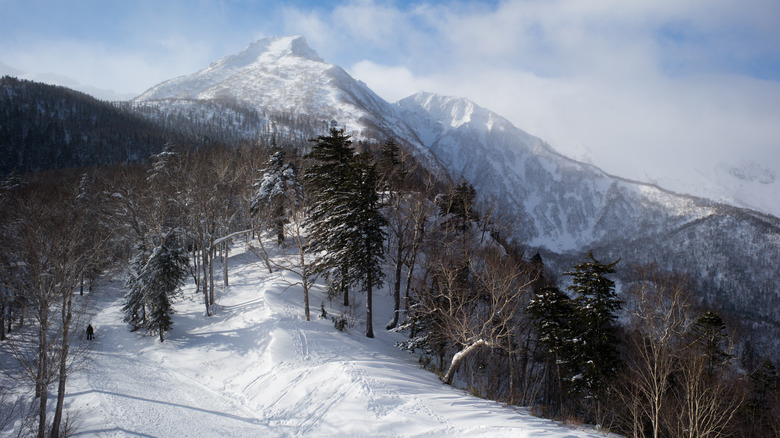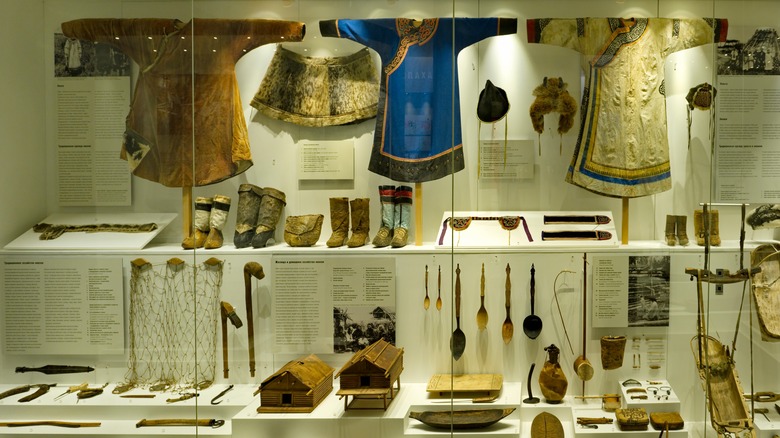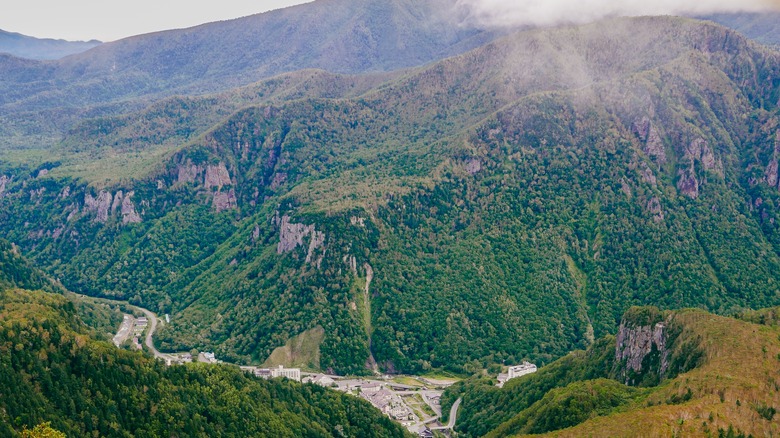Japan's 'Playground Of The Gods' Is A Dramatically Rugged Mountain Range Brimming With Wildflowers
When you mention Japan, most people will immediately think of its bustling capital, Tokyo, or perhaps Osaka, the city nicknamed "Japan's Kitchen." Not many, however, would think of Hokkaido (the most northern of Japan's islands), well known for its ski resorts and hot springs. Hokkaido's capital, Sapporo, is an extremely underrated city that feels like Switzerland's iconic Zermatt without the crowds. But right at Hokkaido's heart lies a vast expanse of dramatic peaks, winding rivers, and active volcanoes known as Daisetsuzan National Park, which means "great snowy mountains" in Japanese — and for good reason.
Daisetsuzan not only boasts Hokkaido's tallest mountain, Mount Asahidake, but also a handful of other peaks rising to more than 6,000 feet above sea level. The sweeping slopes of Mount Asahidake are covered in blankets of powdery snow from November until May, a paradise for expert off-piste skiers and snowboarders. Once the snow melts, hiking trails along the foothills bring trekkers and campers eager to admire the summertime bloom of vibrant alpine flowers or the tinge of brilliant orange foliage during the autumn. Rivers have carved deep gorges in the craggy terrain, and majestic waterfalls tumble from the rugged cliffs. The sprawling national park is also dotted with an abundance of natural hot spring resorts that can be enjoyed throughout all seasons.
Hokkaido's indigenous Ainu people, who have inhabited the land for centuries before the arrival of mainland Japanese settlers, believe that the world around us, from plants and trees to rivers and mountains, is inhabited by godly spirits. Their reverence for the pristine landscape around Daisetsuzan was so great that, in their native language, they named the mountains Kamuy Mintar, or "the Playground of the Gods." So pack up your hiking boots, warm clothes, and ski gear, because a vacation in Daisetsuzan National Park is sure to be awe-inspiring.
Outdoor adventures around Daisetsuzan National Park
There's no shortage of activities for outdoor enthusiasts to enjoy in the Daisetsuzan area. Asahidake Onsen, a charming hot spring resort town sitting on the flatland around Mount Asahidake, is a great starting point for some backcountry skiing amidst untouched natural terrain. Expert hikers can also take the cable car from Asahidake Onsen to Sugatami Station on the mountain's slope, where a lengthy but picturesque hiking trail brings you to the mountain's summit. Taking about four hours there and back, this trail passes across the Susoaidaira Plateau, which is where you'll be able to see the stunning alpine wildflower blooms. Beginner hikers can choose the shorter course to the summit, a 30-minute trail around Sugatami Pond, enjoying the spectacular alpine scenery along the way.
On the other side of the national park, you'll find Sounkyo Onsen, another cozy resort town, where a ropeway connects visitors to the slopes of Mount Kurodake. The backcountry ski runs here, while offering spectacular views, are also only suitable for experts. Hiking trails around Mount Kurodake are also just as breathtaking and accessible to all levels. The ropeway and chairlifts stop at several observation decks along Mount Kurodake's slopes, and from the final deck it's a roughly 90-minute hike to the peak. Don't miss the two incredible waterfalls near Sounkyo Onsen, called Ginga no Taki, translated as "Milky Way Falls," and Ryusei no Taki, meaning
Shooting Star Falls." You can drive there from Sounkyo Onsen in about five minutes, then take a short hike up to an observation deck for fantastic views of the frothy white water flowing down the jagged cliffside. And after a busy day exploring the great outdoors, the hot spring baths at both Asahidake Onsen and Sounkyo Onsen will be a perfect place to relax.
Cultural sights around Daisetsuzan National Park
For those who enjoy more cultural pursuits, worry not. The closest major town to Daisetsuzan is Asahikawa, on the western side of the national park. Here you'll be able to visit the Asahikawa City Museum, which is dedicated to preserving the history of Hokkaido's indigenous Ainu culture. Wander through fascinating exhibits that include dioramas of daily life as well as incredible artifacts like traditional clothing, intricately carved tools, and ritual objects for spiritual worship. There's even a reconstruction of a primitive thatched hut furnished with household fittings, which gives a glimpse into the prehistoric origins of Ainu peoples. Entry tickets cost just over $2, and according to reviews on Tripadvisor, the museum is a "hidden gem" that's certainly "worth a visit." Also not too far away is the Kawamura Kaneto Ainu Memorial Museum, which also shouldn't be missed. Not only are there incredible exhibits displaying a plethora of traditional artifacts, but visitors can even take part in craft workshops for a fully immersive experience of the Ainu way of life.
If you visit Daisetsuzan National Park from the end of January until late March, you'll be just in time to see the Ice Waterfall Festival at Sounkyo Onsen. This annual wintery event is a celebration of Hokkaido's harsh climate, bringing joy to locals, visitors, and children alike despite the freezing temperatures. The festival features an array of towering ice sculptures and monstrous snow domes, meandering through tunnels and mazes. Some of the ice sculptures can even be climbed, and in the evenings, you can enjoy colorful illumination and projection mapping. Stage performances offer additional entertainment, and there's even a bunny slope for snowtubing and sledding. A heated pavilion provides respite from the wintry fun, and on certain evenings, there will be a spectacular fireworks show.
How to get to Hokkaido and Daisetsuzan National Park
You can reach Hokkaido by flying into Sapporo, with connections from major hubs like New York and Los Angeles. You might even want to spend time in Sapporo first, especially since there are several nearby destinations for a fall foliage getaway. From Sapporo, you could then opt for the express train bound for Asahikawa, or pick up a rental car to drive there. Both journeys take just under two hours. If you decide to stay in Asahikawa, there are plenty of cozy accommodations. The Premier Hotel Cabin Asahikawa offers public hot spring baths, plus guest rooms large enough for a family stay. Another option is the Hotel Amanek, with stylish minimalist bedrooms. Both hotels are a short distance from Asahikawa's train station, which can get you to either Asahidake Onsen or Sounkyo Onsen in under two hours.
For stays in Asahidake Onsen, the Hotel Bear Monte is highly rated, and not only includes elegantly spacious guest rooms and public hot spring baths, but also a library and a coffee shop. Over in Sounkyo Onsen, a stay at the Kankou Hotel is sure to be relaxing, with the option of Western-style rooms or traditional Japanese rooms overlooking the Daisetsuzan mountains, along with spa facilities. A visit to Daisetsuzan National Park from late June to August will be best for hiking, while autumn leaf peeping can be enjoyed from the end of September until mid-October. If possible, allow for flexibility on which days you decide to visit, and check the weather forecast before making any firm plans, as heavy rain and winds may result in cable car closures and an overall unpleasant experience. But whether you're there to hike, ski, or sightsee, a trip to the "Playground of the Gods" will be unforgettable.



